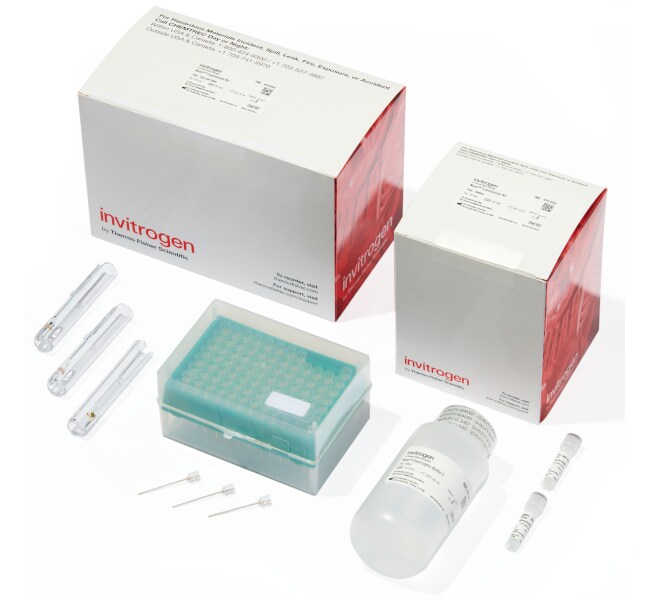Search Thermo Fisher Scientific

Neon™ Transfection System 10 μL Kit
| Catalog Number | No. of Reactions |
|---|---|
| MPK1096 | 96 x 2 |
| MPK1025 | 25 x 2 |
Air Freight Restricted Products - 2-4 business days for Beijing, Shanghai, Guangzhou, Shenzhen and provincial capitals, 3-5 business days for 2nd-tier cities, and 6-10 business days for 3rd-tier cities and remote areas.
Supply Center: Delivered from the Supply Center closest to you.
• 3 x 1 mL Resuspension Buffer T
• 2 x 150 mL Electrolytic Buffer E
• 96 x 10 μl Neon™ tips
• 20 Neon™ electroporation tubes
Store the buffer box 4°C and the tips and tubes box at room temperature.
Figures



Customers who viewed this item also viewed
Documents & Downloads
Certificates
Safety Data Sheets
Product Information
Scientific Resources
Frequently asked questions (FAQs)
Here are possible causes for low transfection efficiency using the Neon device:
1. Sub-optimal electrical parameters
2.Poor plasmid quality such as endotoxin contamination
3 .Plasmid preparation containing high salt
4. Plasmid quantity too high
5. Cells are stressed or damaged
6. Using same Neon tip more than two times
7. Microbubbles in tip, causing arcing
Find additional tips, troubleshooting help, and resources within our Transfection Support Center.
Here are possible causes for low transfection efficiency using the Neon device:
1. Sub-optimal electrical parameters
2. Plasmid preparation containing high salt
3. Plasmid larger than 10 kb
4. Plasmid concentration too low
5. Cells are stressed, damaged, or contaminated by Mycoplasma
6.Cell density too low or too high
7. Cells with high passage number
Find additional tips, troubleshooting help, and resources within our Transfection Support Center.
To determine the Neon transfection efficiency for siRNA, we recommend transfecting the cells with a fluorescent-labeled negative control siRNA (BLOCK-iT Fluorescent Oligo, Cat. No. 13750062) and measuring the transfection efficiency by the percentage of fluorescent-stained cells among viable cells. However, keep in mind that there is a caveat with this approach: the transfection efficiency determined by fluorescent-labeled negative control siRNA may over-estimate the transfection efficiency, as fluorescence detection with a microscope does not distinguish the siRNA that enters the cell from the siRNA that sticks to the cell membrane. To measure transfection efficiency more accurately, one needs to transfect the cells with a positive control siRNA such as the one that targets a house-keeping gene, and measure the knockdown of target RNA or protein.
Find additional tips, troubleshooting help, and resources within our Transfection Support Center.
Cell viability is the number of cells that are confirmed viable from a total cell population. Transfection efficiency is the number of cells that are successfully expressing your construct out of the total number of viable cells (i.e., GFP-positive cells).
Cell viability can be determined by staining cells with propidium iodide or by the trypan blue exclusion method. For adherent cells, cell detachment can be performed using Trypsin or TrypLE Express enzyme prior to staining. Transfection efficiency can be determined using a fluorescence microscope with filter settings appropriate for the detection of GFP (emission: 509 nm). Cells may be counted either by FACS or using the Countess Automated Cell Counter.
Find additional tips, troubleshooting help, and resources within our Transfection Support Center.
As the stability and half-life of various mRNAs and their protein products varies, it is important to empirically determine the best time points for assessing target knockdown. For example, it has been documented that in mammalian cells, mRNA half-life can range from minutes to days (Ross J, 1995, Microbiol Rev 59:423–450) while the half-life of protein products can range from less than a few minutes to several days. In general, the recommended time course ranges from 12 to 72 hours to knock down target mRNA and 24 to 96 hours to adequately knock down target proteins. We recommend measuring mRNA knockdown by qPCR at 8, 24, 48, 72, and 96 hours post-electroporation to determine the time point for maximum knockdown. Also, perform time-course analysis to determine protein knockdown by ELISA (more accurate) or immunoblotting (less accurate).
Find additional tips, troubleshooting help, and resources within our Transfection Support Center.